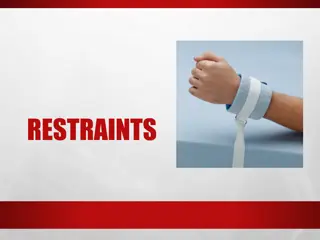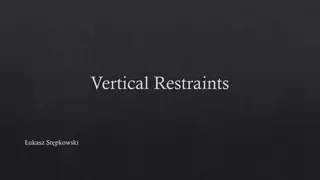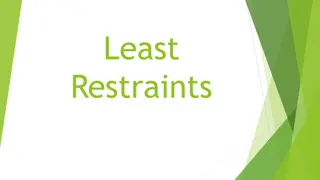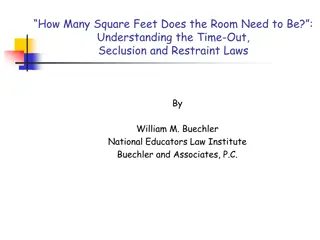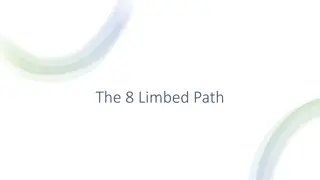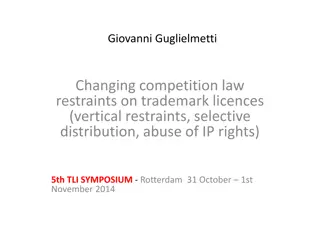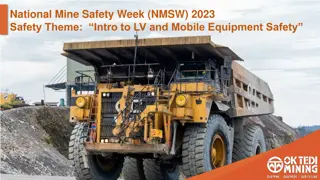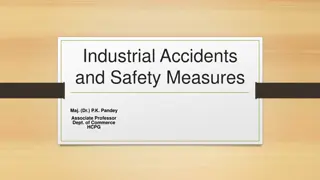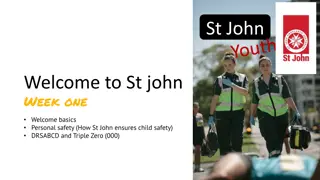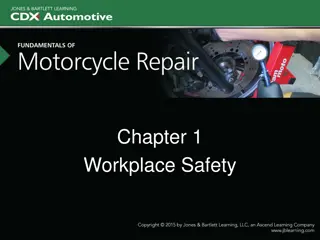Child Restraints: Safety Measures and Equipment Guide
Children may need to be restrained for various medical procedures to ensure safety and facilitate examinations. Proper restraint tools and techniques are essential for protecting the child from harm and discomfort. Important articles like bandages, cotton pads, and jackets play a key role in the process, ensuring a safe and secure restraint experience.
Uploaded on Sep 13, 2024 | 0 Views
Download Presentation

Please find below an Image/Link to download the presentation.
The content on the website is provided AS IS for your information and personal use only. It may not be sold, licensed, or shared on other websites without obtaining consent from the author. Download presentation by click this link. If you encounter any issues during the download, it is possible that the publisher has removed the file from their server.
E N D
Presentation Transcript
Children may need to be restrained for some diagnostic procedures, therapeutic procedures or during the physical examination and sometimes to protect from an injury An appropriate safe and comfortable restraint should be selected. The restraint may be provided manually with help of some device
To carry out the physical examination To provide the safety to child To protect the child from injury To complete the diagnostic and therapeutic procedures To maintain the child in prescribed position To reduce the discomfort of child during some tests and procedures like specimen collection
Wooden plastic sticks (spatula) to keep in for elbow restraint
POINTS TO REMEMBER WHILE RESTRAINING
Always select the safe and appropriate restraint Restraint should not be too tight; it should not interfere with the normal circulation Use appropriate cotton pads for maintaining the comfort of child Restraint should demonstrate to the child, on the child doll to gain the cooperation and reduce the anxiety Explain the restraint and it to comportment that the child should be able to understand
Always maintain comfort to the child and maintain body alignment Open the restraint knot, when the side rails are eased to prevent traction Observe the restraint every 20-30 minutes to prevent any complications
Change the side of child to prevent pressure sore Do not give too much tight knot. It should be easily releasable Do not provide purposeless restraining Do the recording and reporting properly
TYPES OF RESTRAINING
Mummy restraint is used for the children to restrict the moment of limbs It is used to the children for examination, procedure and treatment of head, neck and face is required For example like scalp vein puncture, ear examination, and eye irrigation, gastric and gastric lavage
PROCEDURE Take blanket or draw sheet and spread it our the bed or table One corner of a small blanket is folded over The infant is paced on the blanket with the neck at the edge of the fold Keep one hand of baby near the body and wrap the baby,s body by holding the corner of the sheet and tuck it under the body in opposite side
Now place another hand near the body and wrap the childs body by holding another corner of sheet and tuck it Now take the rounded sheet at bottom near the leg and fold it towards the chest and tuck it upper level of sheet or we can pin it at lower of sheet It restrict all extremities
ELBOW AND KNEE RESTRAINT Elbow and knee restraint is used to control the flexion of elbow and knee In this a readymade cloth with 6-10 pockets is used Place the cotton on sides of elbow and knee and the knee the wooden or plastic strips on pocket cloth. These pockets are vertical
Place the cloth on elbow and knee and adjust it with central location and tie the both side strips properly This elbow restraint is used in case of face and head surgeries Cleft lip and cleft palate, scalp vein infusion, heart injuries and sutures are good examples of using this elbow restraint
ABDOMINAL RESTRAINT This restraint is used to hold the infant in a supine position on the bed Abdominal restraint should not be too light, so that it cannot interfere with respiration and bowel movement For this restraint, use wide size wooden strips Place the cotton pad appropriately to provide the proper comfort
Extremity Restraint (Ankle & Wrist restraint) This involve the extremity (one or more) restraint to complete some procedures It is used to immobilize the extremities These are various method uses for ankle and wrist restraint
CLOVE HITCH KNOT RESTRAINT It used to immobilize the leg or arm The material for clove hitch can be soft cloth, crepe bandage and inch wide gauze bandage First apply the cotton pad over the wrist, ankle to provide comfort
Prepare a figure of eight by the bandage and place it on the wrist or in the ankle and tie the bandage by knot Knot should not be too tight, or too loose Child can remove the knot, if it is too loose To tight knot can interfere on blood circulation The fingers and toes should be checked for discoloration or any skin rashes
It can be completed by making a mitten The mitten course the all fingers of a hand and restrict the movement of the fingers The hand can be wrapped by gauze or hand can be put in a bag like pouch and tie it properly at the wrist of child Finger restraint is used in case of facial surgeries, burns, intravenous infusion, any eczema of face and body parts Keep the mitten soft and it should not interfere circulation
In this a net is used to cover the child cot Net is attached to the cot frame This net restraint is used to prevent the children climbing over the side rails of cot Inside the crib net, the child is totally free to move, no movement is restricted It mainly prevents the child to climb and fall from the side rails cot
Jacket Restraint In this method, a jacket made up of soft cloth and leather is used This jacket has laces at the back and two long strips The laces are tied at back and long strips tie at the side below the rails under the mattress Child can sit and sleep in supine position while wearing jacket It can use on chair also
This restraint is used to avoid the child from climbing over the side rails, climbing out from chair, bed, cot, etc. It prevent the child from fall and injury Some other types eg. Chest restraints are also used for children who are sitting on a chair or wheel chair to maintain their position and to prevent them from fall and injury
These are made up of electrically non-conductive material These belts are used on stricter and operation labels to prevent the children from falling The belts go around the childs waist and tied to the frame of bed under the mattress
The rails are made up of iron or steel These can be raised when ever need arises and can be decreased as per convenience The main purpose of side rails are to prevent from fall and can be used for other restraints. These are used for children with convulsive disorders also
These are prepared devices which are used to restraint the movements of extremities These are made up of plastic, card board, hard paper, and cotton and gauze pieces These can be applied where ever needed
COMPLICATIONS OF RESTRAINTS
If restraints are not used properly, it can cause various complications or hazards It can interfere the child muscular development due to lack movement If restraint is too tight, it cause obstruction in blood circulation tissue damage, redness, scar formation, discoloration of the skin etc Dislocation of the shoulder joint may occur if the child struggles during application of arm restraints Development of pressure sore, if the child is kept restricted for longer period of time and does not have frequent change of position and skin care Hypostatic pneumonia due to immobility
Ischemia or nerve damage due to constrictive restrains Psychic injury to the child, the child feels that, he/she is punished, attention is self body image Disturbance in psychosocial development To avoid from these hazards, the care giver or nurse should follow the safety precautions Use proper amount of cotton pads, and do not use too tight restraint Always follow continuous observation on child If any application occurs release the restraint and consult with doctor Maintain proper recording and reporting


